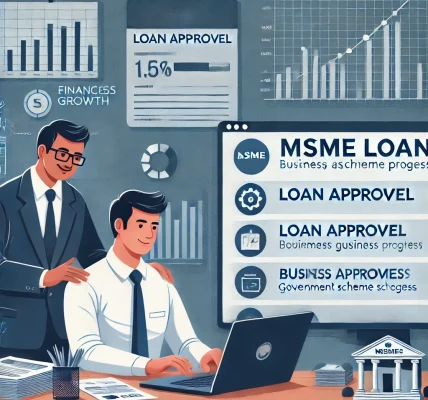Introduction
Micro, Small, and Medium Enterprises (MSMEs) play a crucial role in economic growth by generating employment, fostering innovation, and contributing to exports. However, access to finance remains a significant challenge for small businesses. To address this issue, governments and financial institutions offer various MSME loan schemes designed to provide affordable credit and financial support.
In this guide, we will explore different MSME loan schemes, their benefits, eligibility criteria, application process, and tips to maximize your chances of securing funding.
Understanding MSME Loan Schemes
MSME loan schemes are financial assistance programs aimed at providing businesses with funds to:
- Expand operations
- Purchase machinery and equipment
- Improve working capital
- Invest in technology and innovation
- Meet export and trade-related expenses
These loans typically come with lower interest rates, flexible repayment options, and minimal collateral requirements.
Types of MSME Loan Schemes
1. Government-Backed Loan Schemes
Governments worldwide offer subsidized loans and credit guarantee schemes for MSMEs. Some prominent schemes include:
a) MUDRA Loan Scheme (India)
The Micro Units Development and Refinance Agency (MUDRA) provides loans under three categories:
- Shishu – Loans up to ₹50,000 for early-stage businesses
- Kishor – Loans from ₹50,000 to ₹5 Lakhs for growing businesses
- Tarun – Loans from ₹5 Lakhs to ₹10 Lakhs for expansion and diversification
b) Credit Guarantee Fund Trust for Micro and Small Enterprises (CGTMSE)
This scheme provides collateral-free loans up to ₹2 Crores, ensuring that MSMEs can access credit without pledging assets.
c) Stand-Up India Scheme
Targeted at women and SC/ST entrepreneurs, this scheme offers loans from ₹10 Lakhs to ₹1 Crore for greenfield enterprises.
d) Prime Minister’s Employment Generation Programme (PMEGP)
Aimed at new entrepreneurs, this scheme provides subsidized loans for manufacturing and service businesses.
2. Bank and NBFC Loans for MSMEs
Apart from government schemes, banks and Non-Banking Financial Companies (NBFCs) offer various loan products such as:
- Term Loans – Used for purchasing machinery, infrastructure, and business expansion.
- Working Capital Loans – Helps businesses manage daily expenses and short-term financial needs.
- Overdraft Facility – Allows MSMEs to withdraw more than their account balance up to a sanctioned limit.
- Equipment Financing – Specifically designed to help businesses purchase new equipment and machinery.
3. Startup and Innovation Loans
For businesses focused on technology and innovation, several government and private funding options exist:
- Startup India Seed Fund Scheme
- SIDBI’s Fund of Funds for Startups (FFS)
- Technology Upgradation Fund Scheme (TUFS)
Benefits of MSME Loans
MSME loan schemes offer several advantages, including:
- Lower Interest Rates – Many government-backed loans come with subsidized interest rates.
- No or Minimal Collateral – Programs like CGTMSE provide credit without the need for security.
- Flexible Repayment Terms – Loan repayment schedules are designed to match business cash flow cycles.
- Quick Processing and Disbursal – Many lenders offer fast-track loan approvals to MSMEs.
- Financial Inclusion for Small Businesses – Ensures even small-scale entrepreneurs have access to credit.
Eligibility Criteria for MSME Loans
While specific eligibility criteria vary by scheme, common requirements include:
- Business must be registered as an MSME
- Minimum business turnover as per lender’s requirement
- Good credit score (typically 650+ for private loans)
- Business plan demonstrating loan utilization and repayment capability
- Compliance with legal and financial documentation requirements
How to Apply for MSME Loans
1. Determine Your Loan Requirement
Assess your business needs and choose the appropriate loan scheme.
2. Check Eligibility and Documentation Requirements
Commonly required documents include:
- Business registration certificate
- PAN and Aadhaar card of business owner
- Bank statements (last 6–12 months)
- Financial statements (balance sheet, income statement)
- Income Tax Returns (ITR) for the past two years
3. Select the Right Lender
Compare interest rates, repayment terms, and processing fees before choosing a bank, NBFC, or government-backed lender.
4. Submit Your Loan Application
Applications can be submitted online via government portals like:
- Udyam Portal for MSMEs
- MUDRA Portal for MUDRA loans
- Bank/NBFC Websites for private loans
5. Loan Approval and Disbursement
Once approved, funds are typically disbursed within a few days to weeks, depending on the lender’s process.
Tips to Improve Loan Approval Chances
1. Maintain a Good Credit Score
A credit score above 650 increases approval chances and may lead to better loan terms.
2. Ensure Proper Documentation
Incomplete paperwork can lead to delays or rejection. Always verify required documents before submission.
3. Show Strong Business Financials
Lenders prefer businesses with stable revenue and a clear repayment strategy.
4. Apply for the Right Loan Amount
Borrow only what your business needs to avoid repayment difficulties.
5. Utilize Government Resources
Leverage MSME support centers and online resources to gain guidance on loan applications.
Common Challenges and How to Overcome Them
1. High Rejection Rates Due to Poor Credit History
- Solution: Improve your credit score by making timely payments and reducing outstanding debt.
2. Insufficient Collateral for Traditional Loans
- Solution: Opt for collateral-free government schemes like CGTMSE and MUDRA loans.
3. Lengthy Approval Process
- Solution: Apply through online lending platforms that offer quick processing.
Conclusion
MSME loans are essential for small businesses to scale, sustain, and compete in the market. By understanding different loan schemes, eligibility criteria, and best practices for application, entrepreneurs can secure the necessary funding to grow their businesses.




